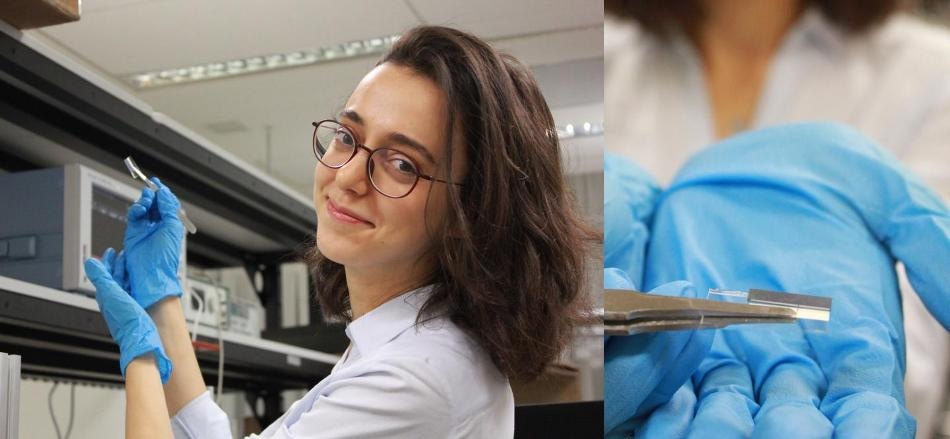Jul 4 2019
A tsunami is capable of holding its wave shape over vast distances across the ocean, preserving its “information” and power far from its origin.
 PhD student and lead author Sahin Ezgi from the Singapore University of Technology and Design holds one of the experimental chips. (Image credit: Singapore University of Technology and Design)
PhD student and lead author Sahin Ezgi from the Singapore University of Technology and Design holds one of the experimental chips. (Image credit: Singapore University of Technology and Design)
In communications science, preserving information in an optic fiber that spreads across continents is crucial. Preferably, this requires the exploitation of light in silicon chips at the source and reception end of the fiber without modifying the wave shape of the photonic packet of information. However, scientists have not been able to achieve this until now.
A partnership between the University of Sydney Nano Institute and Singapore University of Technology and Design has for the first time controlled a light wave, or photonic information, on a silicon chip that preserves its general “shape”.
These kinds of waves — whether a tsunami or a photonic packet of information — are called “solitons.” The Sydney-Singapore team has for the first time seen “soliton” dynamics on an ultra-silicon-rich nitride (USRN) device created in Singapore using advanced optical characterization tools at Sydney Nano.
This foundational research, published recently in Laser & Photonics Reviews, is crucial because most communications infrastructure still depends on silicon-based devices for transmission and reception of information. The exploitation of solitons on-chip could actually allow for the acceleration of photonic communications devices and infrastructure.
Ezgi Sahin, a PhD student at SUTD carried out the experiments with Dr Andrea Blanco Redondo at the University of Sydney.
“The observation of complex soliton dynamics paves the way to a wide range of applications, beyond pulse compression, for on-chip optical signal processing,” Ms Sahin said. “I’m happy to be a part of this great partnership between the two institutions with deep collaboration across theory, device fabrication, and measurement.”
This represents a major breakthrough for the field of soliton physics and is of fundamental technological importance. Solitons of this nature—so-called Bragg solitons—were first observed about 20 years ago in optical fibres but have not been reported on a chip because the standard silicon material upon which chips are based constrains the propagation.
Professor Ben Eggleton, Study Co-Author and Director, Sydney Nano
Eggleton added, “This demonstration, which is based on a slightly modified version of silicon that avoids these constraints, opens the field for an entirely new paradigm for manipulating light on a chip.”
We were able to convincingly demonstrate Bragg soliton formation and fission because of the unique Bragg grating design and the ultra-silicon-rich nitride material platform (USRN) we used. This platform prevents loss of information which has compromised previous demonstrations.
Dawn Tan, Study Co-Author and Professor, SUTD
Solitons are pulses that spread without any change in shape and can survive impacts and interactions. They were first noticed in a Scottish canal 150 years ago and are acquainted in the context of tsunami waves, which spread thousands of kilometers without any change in shape.
Optical soliton waves have been explored since the 1980s in optical fibers and offer huge promise for optical communication systems because they allow data to be transmitted over long distances without being altered. Bragg solitons, which get their properties from Bragg gratings (intermittent structures etched into the silicon substrate), can be explored at the scale of chip technology where they can be derived for innovative signal processing.
They are named Bragg solitons after Australian-born Lawrence Bragg and his father William Henry Bragg, who first introduced the theory of Bragg reflection in 1913 and were later bestowed with the Nobel Prize in Physics. They are the only father and son duo to have received Nobel Prizes.
Bragg solitons were first noticed in 1996 in Bragg gratings in optical fibers. Professor Eggleton demonstrated this occurrence when he was working on his PhD at Bell Labs.
The Bragg grating device’s silicon-based nature also guarantees compatibility with complementary metal oxide semiconductor (CMOS) processing. The ability to dependably trigger soliton compression and fission allows ultrafast occurrences to be produced with longer pulses than formerly required. The chip-scale miniaturization also boosts the speed of optical signal procedures in applications requiring compactness.